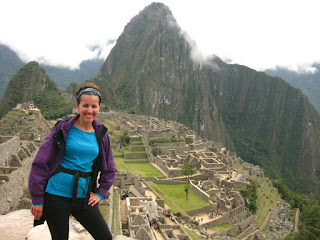
When we arrive at Machu Picchu, everything is covered
in a thick layer of fog.

WE ARE HERE!
We wake up at 4:30 in the morning to set out for Machu Picchu. After four days of struggle and hiking, we have finally made it!
A thick, heavy fog hangs low as we enter the grounds. The fog lends a mystical feeling to this ancient, mysterious architectural feat. We are finally here: Machu Picchu.
After all the effort and hype, we are here. We are here, and it is all worth it, every second.
From our vantage point, we can see it all; the religious and scientific center, the residential district, the famed terraces, and the dramatic jagged cliffs of Wayna Picchu Mountain. To stand above this, looking down, is truly awe inspiring.
We complete our three hour tour and spend more time wandering around the grounds, pondering the Incas. What was this city used for? Why was it abandoned? How did they possibly manage to build this into the side of a mountain? We marvel at the trails that approach it from all sides. Compared to the other half dozen ruin sites we have visited, this is far and away the most impressive. Above all else, the Incas were amazing architects and builders.
No photo or post card had adequately prepared us for the imposing grandeur of this ancient ruin. The day flew by as we explored all things Machu Picchu.













